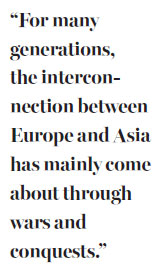Modern revival of ancient connection
Updated: 2016-09-23 07:58
By Wang Yiwei(China Daily Europe)
|
|||||||||
Land links could help to share the wealth and prosperity with more inland communities
The rise of the Ottoman Empire in the 15th century cut down the old Silk Road. European people turned to the sea in their search for goods, and started the colonization of many regions in the world. But the globalization they created is mainly the globalization of the sea.
According to data from the World Bank, about 80 percent of the world's output comes from regions that are within 100 kilometers of the sea, because about 70 percent of the planet is covered by ocean, and about 90 percent of trade is transported by water.
In the Europe and in the US, logistical costs account for 6 to 8 percent of GDP. In many Asian countries, this rate is about 20 percent. So the result is that the competitiveness of Asian countries' products and industries is difficult to improve, and the economic development of the inland regions of Europe and Asia is severely stagnated.
Reviving the Silk Road has become the common dream of many countries along its route. However, for many generations, the interconnection between Europe and Asia has mainly come about through wars and conquests. Railways provide the technology for connecting Europe and Asia. Several schemes have been put forward but none have yet succeeded. Now the task has been placed on Chin'as shoulders.
During the transition from traditional to high-speed railways, China has built about 20,000 km of track in the past 10 years, accounting for more than 75 percent of that of the whole world. So China is well placed to initiate the Belt and Road.

Moreover, China's strong currency reserve and manufacturing ability also provide advantages. There are already more than 20 routes from cities in China to Europe, which cut transport times by half compared with sea routes, but the cost is twice that of shipping. For example, Yuxinou railway, which starts in Chongqing and ends in Duisburg, Germany, takes 16 days, while the shipping routes used to take 35 days. Its cost is about $6,000 to $8,000 per container, while that of shipping is about $3,500.
Prices for railway transportation do not look so cheap for companies, so the railways still rely on local government subsidies. Trains making the trip back from Europe are usually empty, due to the lack of scale economy, and insufficient connection in policies and technology of countries along the road.
Thus China initiated the Belt and Road Initiative, which proposed interconnection of countries along the Belt and Road in five aspects: policies, infrastructure, trade, capital, and people exchanges. It will also connect the sea routes with the continent, reducing the logistical costs.
The Belt and Road Initiative will help with China's economic transformation, reduce logistic costs, increase the competitiveness of Asian and African countries, and reduce the gap between inland and coastal countries.
China's Belt and Road Initiative could be seen as two Silk Roads, one on the continent and one on the sea.
It would become an interconnected transportation network that consists of railways, highways, aerospace, shipping, pipelines, electronic transmission lines and telecommunications networks. Along all these networks, there will be some industrial clusters, which in the end would form an economic corridor consisting of sectors such as construction, energy, finance, telecom, logistics, tourism, and so on.
The author is a professor at the School of International Relations and Center for European Studies at Renmin University of China. The views do not necessarily reflect those of China Daily.
(China Daily European Weekly 09/23/2016 page8)
Today's Top News
State of emergency declared in US city amid protests
Universities given boost in rankings
Demand for Mandarin rises in UK
China 'capable of keeping medium-to-high growth'
Li tells Obama of opposition to THAAD deployment
Greek vows to improve refugee situation on island
UN suspends aid convoys following deadly strikes
New York bombing suspect captured in New Jersey
Hot Topics
Lunar probe , China growth forecasts, Emission rules get tougher, China seen through 'colored lens', International board,
Editor's Picks

|

|

|

|

|

|







